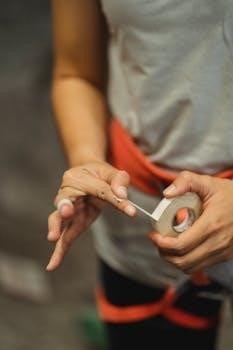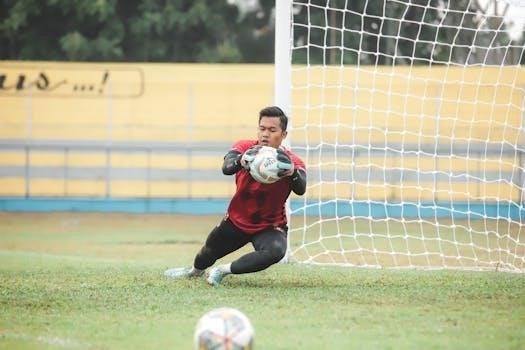aristoti athletic tape instructions

Aristoti athletic tape is a specialized tool used by athletes and medical professionals. This non-elastic, 100% cotton tape provides support and stability to joints and muscles. It aids in injury prevention and performance enhancement during athletic activities and is known for its comfort.
What is Athletic Tape?
Athletic tape is a specialized adhesive tape, often made from cotton, designed to provide support and stability to muscles, joints, and ligaments during physical activity. It’s a pressure-sensitive tape, similar to surgical tape, but it’s specifically engineered for athletic use. Unlike kinesiology tape, athletic tape is generally non-elastic, offering rigid support rather than dynamic movement assistance. This type of tape is crucial in both injury management and prevention. It works by physically holding muscles and bones in a stable position, which can reduce pain and aid recovery. The application of athletic tape typically involves directly adhering the tape to the skin or over pre-wrap, depending on the specific application and desired level of support. The tape is known for its strong adhesive properties, ensuring it stays in place during intense physical activities. Athletic tape is an essential tool for athletes and medical professionals for its reliable support and stability.
Purpose of Athletic Taping
The primary purpose of athletic taping is to provide support and stability to muscles, joints, and ligaments, thereby reducing the risk of injuries during physical activities. It’s commonly used to restrict the movement of injured joints, offering a protective mechanism for athletes with existing injuries. Athletic taping also aids in soft tissue compression, which helps to reduce swelling and inflammation. By physically holding muscles or bones in a certain position, the tape assists in pain reduction and promotes recovery. Additionally, it can enhance performance by providing a sense of stability and confidence to athletes. Whether used as a temporary measure or as an adjunct to other treatments, athletic taping is a versatile technique for both injury prevention and management. The application of athletic tape is a common practice among athletes and medical professionals, utilizing the tape’s strong adhesive properties and ability to provide rigid support.

Preparing for Aristoti Athletic Tape Application
Proper preparation is crucial for effective taping. This includes cleaning the skin, applying pre-wrap for protection, and ensuring the skin is dry before applying the tape;
Skin Preparation
Before applying Aristoti athletic tape, meticulous skin preparation is essential for optimal adhesion and to prevent irritation. Begin by thoroughly cleaning the area with mild soap and water, ensuring the removal of any oils, lotions, or dirt. After washing, dry the skin completely with a clean towel; moisture can hinder the tape’s ability to adhere properly. If necessary, consider using an alcohol wipe to further degrease the skin. For individuals with excessive body hair, trimming or shaving the area may be beneficial to ensure a smooth tape application and to prevent discomfort upon removal. Avoid applying any moisturizers or skin products immediately before taping. These steps ensure that the tape adheres effectively to the skin, maximizing its support and therapeutic benefits. This also aids in preventing skin reactions and ensuring that the tape stays in place for the required duration.
Applying Pre-Wrap
Applying pre-wrap is a crucial step before using Aristoti athletic tape, particularly when taping directly on the skin. Pre-wrap, a thin, foam-like material, creates a protective barrier between the skin and the adhesive tape, reducing the risk of irritation or discomfort upon removal. Begin by wrapping the pre-wrap smoothly around the targeted area, overlapping each layer slightly to ensure even coverage. Avoid pulling the pre-wrap too tightly, as this can restrict circulation. Use only a small, thin amount of pre-wrap, covering from the middle of the calf to the arch of the foot for ankle applications. The pre-wrap should extend slightly beyond the area where the athletic tape will be applied. This layer of pre-wrap enhances comfort and protects the skin, making the taping process more comfortable and effective while also aiding in easy tape removal.

Basic Aristoti Athletic Tape Techniques
Mastering basic techniques is crucial for effective Aristoti athletic tape application. This includes creating secure anchors, applying stirrup strips, and using figure-eight strips for support, ensuring stability and injury prevention.
Creating Anchors
Creating secure anchors is a fundamental step in applying Aristoti athletic tape, ensuring the tape adheres properly and provides the necessary support. Anchors are typically applied directly to the skin or over pre-wrap, serving as a base for subsequent taping techniques. They provide a stable foundation, preventing the tape from shifting or slipping during activity. It’s essential to use a sufficient amount of tape to create a robust anchor, typically overlapping the tape by about half its width. The tape sticks best when attached to tape rather than directly to skin. This ensures the stirrup strips and other supportive strips have a strong base. Applying a well-formed anchor is critical to the success of the overall taping application. They are the essential starting point for any effective taping strategy, providing a secure foundation for further support and stability.
Applying Stirrup Strips
Applying stirrup strips is a crucial technique in athletic taping, particularly for providing support to the ankle and lower leg. These strips are applied vertically, running from one side of the anchor around the heel or foot and back up to the other side of the anchor. They are typically applied after the initial anchor has been established, providing essential support and preventing excessive movement of the joint. Stirrup strips help to limit inversion and eversion, which are common causes of ankle sprains. They need to be applied with moderate tension, ensuring they are neither too loose nor too tight. Proper application of stirrup strips is vital for providing effective support and enhancing stability to the affected area. Overlapping each stirrup strip slightly is important to ensure there are no gaps. This technique is commonly used for ankle stability and to prevent injuries.
Figure-Eight Strips for Support
Figure-eight strips are a vital technique in athletic taping, especially for providing added support and stability to joints like the ankle. This technique involves applying tape in a figure-eight pattern around the joint, creating a crisscross of support. The figure-eight strip starts on one side of the ankle, goes under the foot, and then crosses back over the top of the ankle, anchoring on the opposite side. These strips are crucial for limiting excessive movement and preventing injuries like sprains. When applying figure-eight strips, it’s important to maintain consistent tension to ensure effective support without restricting circulation. The technique should be applied after the initial stirrup strips. They help to further stabilize the joint. Overlapping the strips slightly ensures there are no gaps. This pattern offers a dynamic range of support.

Specific Applications of Aristoti Athletic Tape
Aristoti athletic tape is versatile, finding use in various applications. It is used to support ankles for stability and also to provide arch support, preventing injuries. The tape helps in rehabilitation.
Ankle Stability Taping
Ankle stability taping is a crucial technique using Aristoti athletic tape, primarily aimed at preventing inversion or eversion injuries. Begin by applying heel and lace pads and pre-wrap to protect the skin. Ensure the pre-wrap covers from the mid-calf to the arch of the foot. Next, create two anchors using the tape itself, as tape adheres better to tape than skin. The initial anchor is placed around the foot, and a second anchor goes around the ankle. Now apply stirrup strips around the foot, securing them with the ankle anchor. For added support, apply figure-eight strips. This method restricts movement of the injured joints and provides soft tissue compression. It’s a temporary technique often used by athletes as a protective measure. Proper application of Aristoti athletic tape enhances stability, reducing the risk of ankle injuries during physical activity.
Arch Support Taping
Arch support taping using Aristoti athletic tape is essential for addressing longitudinal arch strains. This technique provides mild support to the arch of the foot, aiding in pain reduction and recovery. It involves a circular taping method, where tape is applied to provide compression and stability. Begin by preparing the skin, ensuring it’s clean and dry. Then, apply a pre-wrap layer to protect the skin from the adhesive. Next, create anchors on the foot, securing the beginning and end of the arch support strip. Carefully apply the tape along the arch, following its natural curve. This technique helps to support the arch, reducing stress and promoting healing. This method is particularly helpful for athletes experiencing discomfort or strains in the longitudinal arch. Remember to ensure proper application, which is key for achieving maximum benefit. By using this method, the arch is supported during physical activity.

Advanced Aristoti Athletic Tape Considerations
Athletic tape is a powerful tool; understanding when to use it is crucial. It plays a significant role in rehabilitation, supporting recovery, preventing injuries and enhancing athletic performance for various activities.
When to Use Athletic Tape
Aristoti athletic tape is beneficial in various situations, primarily when support and stability are needed for muscles, joints, and ligaments. Athletes often use it as a protective measure, especially when dealing with existing injuries, to restrict movement and reduce swelling. It’s commonly applied to ankles to prevent inversion and eversion injuries, as well as for arch support to help with longitudinal arch strains. Furthermore, athletic tape can be used to provide compression to soft tissues, aiding in reducing inflammation and providing stability during high-intensity training or competitions. Its application is also helpful during recovery, allowing athletes to maintain range of motion while supporting the healing process. Athletic tape is also used to ensure comfort while exercising, and competing. Correct application is key to maximizing its benefits in preventing injuries and supporting recovery. Therefore, understanding the appropriate scenarios for its use is essential for both athletes and medical professionals.
Athletic Tape in Rehabilitation
Aristoti athletic tape plays a crucial role in rehabilitation, serving as a versatile tool for supporting recovery and improving patient outcomes. Its application in physical therapy clinics and sports medicine is widespread due to its effectiveness in providing stability to injured muscles and joints. During rehabilitation, it aids in restricting movement to allow healing, while its unique design allows for flexibility and comfort, which promotes continued activity with reduced risk of further injury. Athletic tape can assist in reducing inflammation by providing soft tissue compression and can also be used to support the longitudinal arch of the foot, helping with strains. Furthermore, using athletic tape correctly can make a significant difference in the healing process, and prevent re-injury. Therefore, its use in rehabilitation is not only about support, but also about facilitating a safe return to activity and ensuring long-term recovery success.
Proper application of Aristoti athletic tape offers significant benefits, including enhanced support, injury prevention, and improved performance. Mastery of taping techniques is crucial for maximizing these advantages, ensuring safety and effectiveness.
Benefits of Correct Application
The correct application of Aristoti athletic tape provides a multitude of benefits, primarily centered around enhanced support and stability for muscles, joints, and ligaments during physical activity. Proper taping techniques can significantly reduce the risk of injuries by limiting excessive movements and providing external support to vulnerable areas. This support not only protects existing injuries but also aids in preventing new ones. Furthermore, when applied accurately, athletic tape can improve athletic performance by enhancing proprioception and allowing athletes to maintain flexibility and comfort. Properly applied tape assists in reducing inflammation, which in turn can lead to an increased range of motion. Moreover, the therapeutic benefits of correct application extend to rehabilitation settings, playing a crucial role in supporting recovery and improving patient outcomes. It is also essential for achieving the desired therapeutic goals and ensuring optimal results from the taping process. In essence, mastering proper application techniques unlocks the full potential of Aristoti athletic tape.